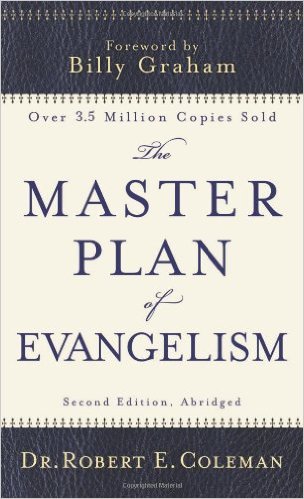Robert Coleman serves as Distinguished Senior Professor of Discipleship and Evangelism at Gordon-Conwell Theological Seminary. He has taught at many theological institutions including Wheaton, Trinity Evangelical Divinity School, and Asbury Theological Seminary. He was one of the founding members of the Lausanne Committee on World Evangelization where he chaired the North American branch. Coleman has vast experience internationally as well having served on the board of several international missions organizations. He has written numerous books and articles dealing with the closely related issues of evangelism and discipleship. The Master Plan of Evangelism has sold over three million copies and has been translated into more than one hundred languages. Christianity Today highlighted this work as one of the most influential books upon evangelicalism in the second half of the twentieth century.
Coleman’s purpose in the Master Plan of Evangelism is to examine the evangelistic strategy of Jesus Christ. By studying the ways of Christ in the gospels, Christians receive a model of evangelism that can be trusted. Coleman acknowledges that some work has been done on Christ’s approach to discipleship, but he claims that work still must be done concerning his method of evangelism. The study could not be more revealing for Jesus is a perfect example. Right from the beginning of the work, Coleman’s scope of evangelism appears. He mentions worldwide evangelism multiple times in the work. Jesus illustrates “God’s strategy of world conquest” (18). But this world conquest will be accomplished through individuals. Coleman notes that the model he prescribes from the life of Christ seems strikingly simple in light of the busyness often associated with evangelism in the modern church. He features eight principles from the Master’s plan.
First, Jesus selected men who would follow him. He roots this idea in Luke 6:13 where Jesus chose the twelve disciples. This was Christ’s strategy for reaching the world: “His concern was not with programs to reach the multitudes, but with men whom the multitudes would follow” (21). The men he selected were not perfect, but they were teachable. This method reveals that Jesus was “not trying to impress the crowd, but to usher in a kingdom” (28). Christ knew that he must entrust his teaching to men who would faithfully deliver it to others. Coleman points out that Christ was so concerned with individuals that he may have had only approximately five hundred followers at the time of his resurrection (1 Corinthians 15:6). Second, Jesus associated closely with the men he selected. In fact, “his whole ministry evolved around them” (37). Coleman applies this point to the church of today by calling for the all the members of the body to be checking up on one another in light of the fast pace of modern society. Third, Jesus consecrated his close followers in that he expected their obedience. He acknowledges that this will minimize the amount of followers today just like it did in Christ’s ministry. Even so, the old ways of the world must be “conformed to the new disciplines of the kingdom” (44). He applies this to the church as a whole: “It is high time that the requirements for membership in the church be interpreted and enforced in terms of true discipleship” (51).
Fourth, Jesus imparted his own life into the men whom he had selected and called to obedience. Rooting this point in John 20:22, Coleman emphasizes the need for the Holy Spirit in any evangelistic method. Modern approaches that lean heavily on human ingenuity can learn much from the Master’s method: “evangelism was not interpreted as a human undertaking, but as a diving project” (57). This does not mean that evangelism is a laid back enterprise. Rather, Jesus “gave all he had—nothing was withheld, not even his own life” (54). The Christian who follows Christ’s method of evangelism must pour his or her life into others by the power of the Holy Spirit. Fifth, Christ demonstrated to his followers what a life of godliness looked like. Christ displayed to his followers the full range of the Christian life. He modeled a life of prayer (Luke 11:1-4; Matthew 6:9-13). He taught them how to evangelize by allowing them to watch him do it. He showed them how to use the Scripture. Coleman notes that there are at least sixty-six references to the Old Testament in his conversations with the disciples. (65). Simply put, Jesus “did not ask anyone to do or be anything which first he had not demonstrated in his own life” (68).
Sixth, Jesus delegated work to those who followed him. Coleman highlights Matthew 4:19 showing the Christ intended to make his followers fishers of men. The disciples took on numerous responsibilities including preparing food, arranging accommodations, baptizing, preaching the kingdom, and healing. Using practical wisdom, Coleman applies this point to modern day evangelism by calling for practical work assignments accompanied by a high expectation that they be completed. Seventh, Jesus supervised his followers. One example of this comes from the regrouping of the disciples after they had been sent out in Mark 6:30 and Luke 9:10. This appears to be a time where Jesus could hear of all that was accomplished during the time of evangelistic ministry. Eighth, Jesus intended his disciples to reproduce. Coleman draws out the accurate thrust of the Great Commission by showing that the controlling verb in the commission is to make disciples. He questions, “when will we realize that evangelism is not done by something, but someone” (97)? Coleman summarizes the problem with modern methodologies and offers the method of the Master instead: “Well-intended ceremonies, programs, organizations, commissions, and crusades of human ingenuity are trying valiantly to do a job that can only be done by people in the power of the Holy Spirit” (96).
It is hard not to like the Master Plan of Evangelism. Many things stand out about the work showing it to be a useful resource. Coleman writes with brevity and precision. He keeps each aspect of Christ’s method clear and to the point. Biblical support litters the pages of the book. Coleman evidences that he has spent much time examining the gospels by the pertinent points he synthesizes from Christ’s leadership of the disciples. Furthermore, Coleman provides fitting application at the end of each chapter, which allows the modern reader to consider how he or she might make life adjustments so as to follow Christ’s method of evangelism. The primary method advanced in this work is that of healthy discipleship as a means to worldwide evangelism. That is, the idea of evangelism is couched in discipleship. Coleman presents a strategy that mirrors the one Christ employed and fits the thrust of the Great Commission. I will draw out three specific benefits that stand out from this work, and then offer a couple critiques.
First, the book provides a worthy correction to the overuse of programmatic evangelistic ministry. Coleman writes in 1963 when crusade evangelism was in full swing. This method may have died down some over the past fifty years, but it can still easily become a substitute for individual discipleship and evangelism. Programs and organizations indeed have their value, but there is a real danger of neglecting the model Christ demonstrated if these programs and organizations are overemphasized. At the same time, modern Christian must not fall into the opposite danger of simply neglecting to do any sort of evangelism. Coleman’s work certainly does not recommend inactivity. He calls for active engagement in the hard work of evangelism modeled after the method of Christ.
Second, Coleman calls for a quantity time commitment to evangelism and discipleship. He compares Christ’s method of evangelism to a father’s care for his children. Any father knows that if he is going to care for his children well, then he must spend a large amount of time with them. In the same way, the Great Commission cannot be accomplished unless Christians sacrifice the resource of time. In a day and age where time is money, this may not be any easy lesson for modern Christians to receive and apply. Multiple Christian discipleship works seems to strike the same note today as many people suffer from a lack of true community. The pace of the world does not appear to be slowing down in the future so Christians must prepare to make great sacrifices in order to spend the time with others that is necessary in order to see the fulfillment of the Great Commission.
Third, the method presented in this book emphasizes the use of Scripture in evangelism. Coleman mentions that Christ expected his followers to obey him and he modeled how to use the word in teaching. This is appropriate for the Great Commission requires teaching as an essential component of disciple making. Often, Christian community can degenerate into surface level social clubs, or worse. Coleman requires that a true method of discipleship and evangelism must include the study and application of God’s word. Any evangelistic approach that neglects the use of Scripture, does not qualify as true evangelism.
One qualification that must be taken in consideration is the difference between the life of Christ and the life of most Christians. When it comes to the evangelistic approach laid down in this work, the life of most Christians differ from the life of Christ in two significant ways. First, Christ was a single man who spent an immense amount of time with his followers, while most Christians are married with children. The vast majority of believers will not be able to spend the same amount of time with their disciples as Christ did with his. Coleman never claims that one must do this in order to be faithful. Nevertheless, it is a point worthy of consideration that helps to qualify the call to follow Christ’s method. Second, Christ was at least to some degree supported financially in his ministry, while most Christians will have full time jobs. This qualification does not mean that they model should not be adopted; it simply calls for wisdom in the implementation of the strategy.
Another point worthy of consideration is the significance of the local church when it comes to evangelism and discipleship. Coleman’s strategy focuses largely on how an individual should engage in evangelism. He writes when there was great focus on how a program serves discipleship so he answers with the need for individual engagement. In light of some of the recent emphasis on healthy local churches, it could be beneficial to consider how the church engages in evangelism in discipleship. For instance, how significant is the Lord’s Day gathering to the growth of disciples? Likewise, how necessary is the preached word, corporate prayer meetings, ordinances, and church discipline to the growth of disciples and thereby the witness of the gospel? Coleman briefly mentions the need of body of Christ, but this point deserves more attention. In light of the differences between the life of Christ and lives of most Christians, a model of evangelism from the perspective of the local church could be an interesting study, in the same way that Coleman’s work is a shift from the perspective of programs to that of the individual. In any case, The Master Plan of Evangelism provides a clear and strategic approach to evangelism that emphasizes the need of following Christ’s method of discipleship.
Coleman presents a theology of disciplemaking rooted in Jesus Christ. Disciplemaking sits at the very heart of his Great Commission. Therefore, discipleship and evangelism go hand in hand. Discipleship refers primarily to following Christ. This is evident in Christ’s own ministry for he told his disciples to follow his way of life. If discipleship is defined as following Christ, then discipleship is marked by Holy Spirit power and Christian obedience. Any effort to follow the way of Christ without the Holy Spirit will be a dismal failure. Thus, discipleship is a work that must be engaged in by the help of the Holy Spirit. Furthermore, discipleship includes obedience to the word of God. This is evident in the Great Commission itself (“teach them to obey all I have commanded”) as well as the ministry of Christ where he displayed high expectations of holiness for his followers. Finally, Coleman sees the goal of discipleship as worldwide conquest for Christ. Although discipleship focuses on individuals, it always keeps this grand aim in view.
Coleman’s method of discipleship finds expression in the life of Christ as well. Christ selected individual men to spend vast amounts of time with. Christians too should find others to spend quantity time with for the purpose of discipleship. Next, Christ poured his life into his followers and demonstrated to them a godly way of life. Here too, Christians must not hold back in their discipleship, but share both their hearts and their lives with those whom they are pouring into. Also, Christ expected his followers to obey him and he often checked up on them to see how they were progressing. In the same way, Christians must expect their disciples to obey God’s word and see that they hold them accountable to do it. Finally, Christ gave his followers work to do and expected them to engage others in the same way that he engaged them. Christians as well must delegate responsibility to those whom they disciple. Christians should both disciple and be a disciple. In each disciple goes out to make another disciple, then this principle of reproduction will occur. Christ did not expect his twelve closest disciples to simply receive from him, but he called them to go and make disciples. This method must be applied to discipleship in the church today.


















